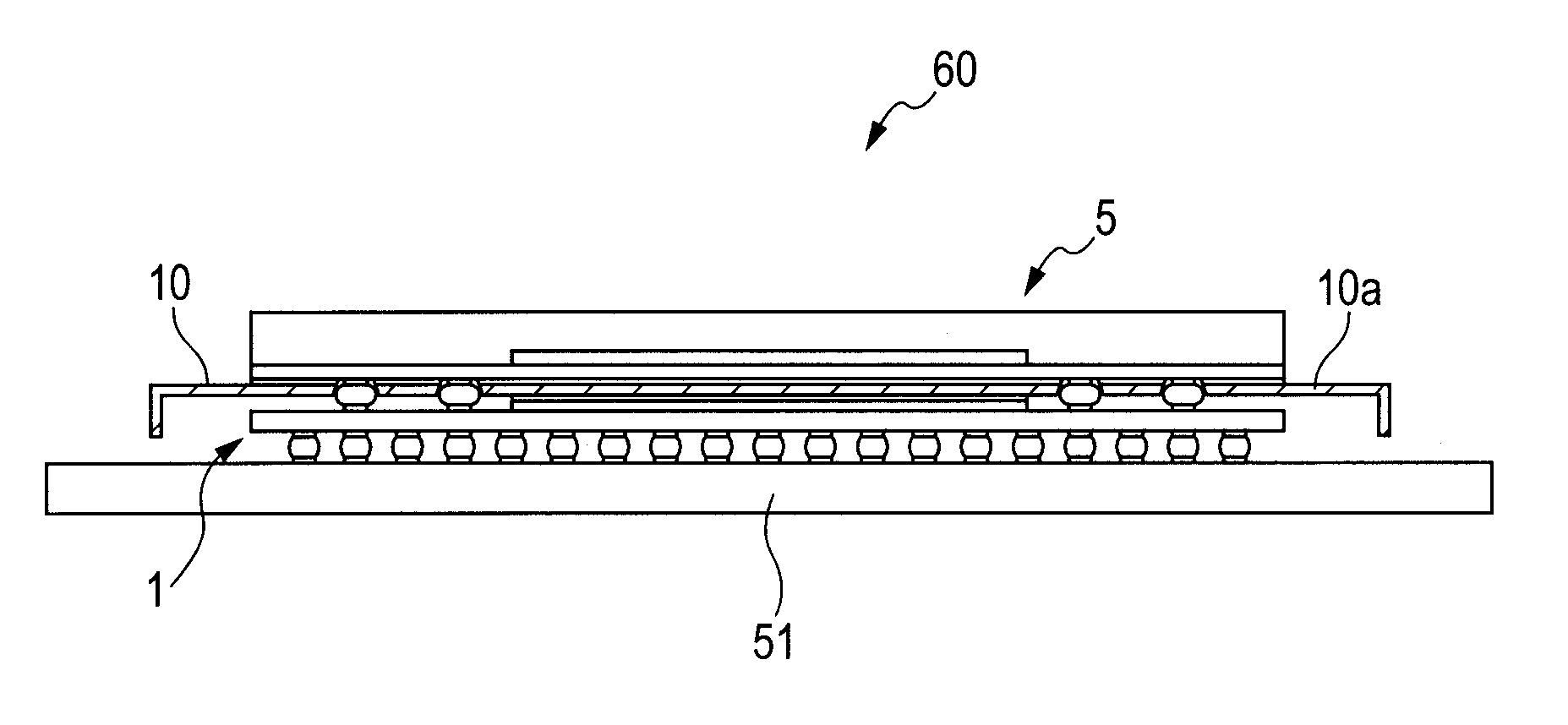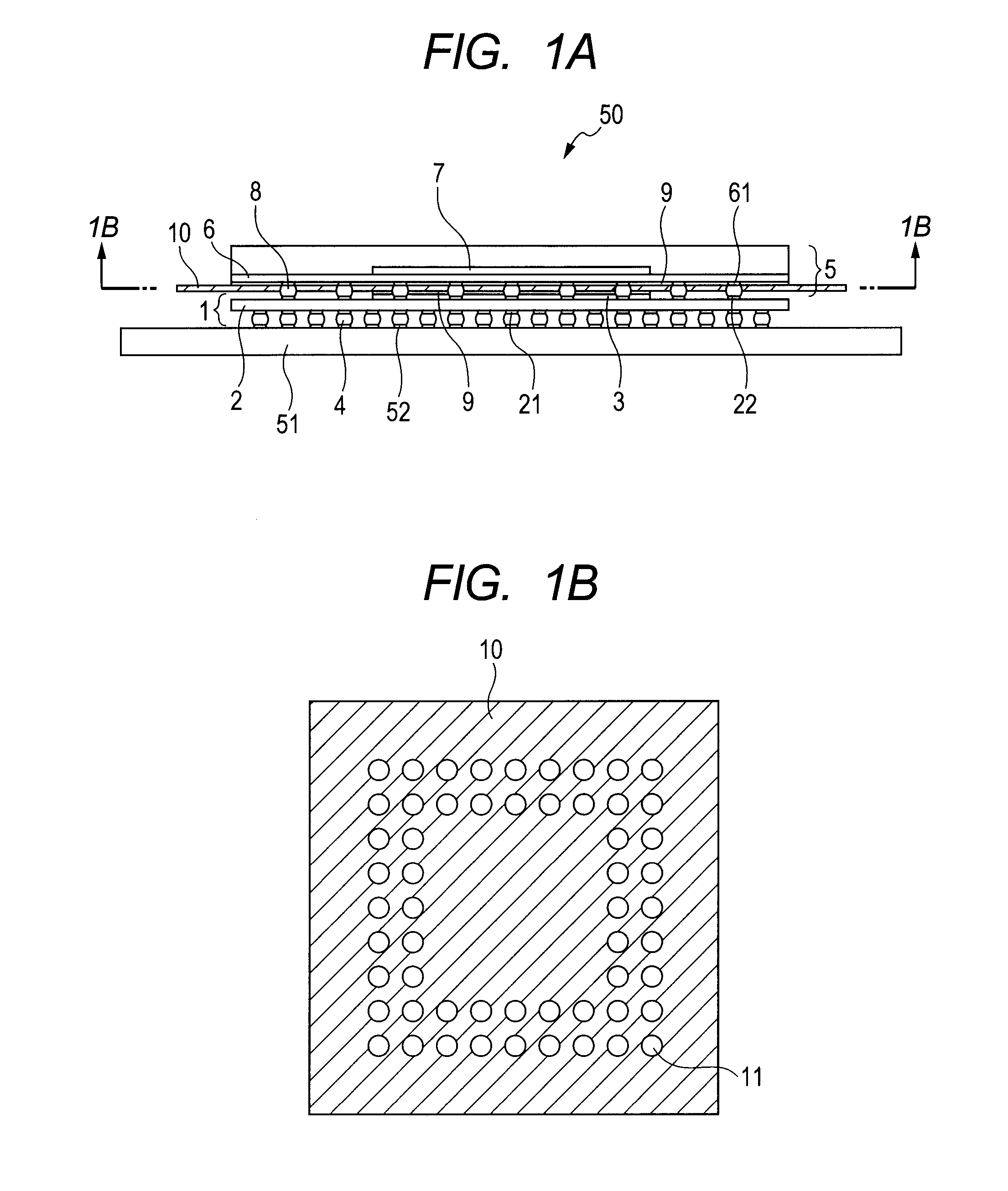Stacked semiconductor device
- Summary
- Abstract
- Description
- Claims
- Application Information
AI Technical Summary
Benefits of technology
Problems solved by technology
Method used
Image
Examples
first embodiment
[0017]A first embodiment for carrying out the present invention is described in detail in the following with reference to the drawings. FIG. 1A is a sectional view of a stacked semiconductor device 50 according to the first embodiment of the present invention.
[0018]The stacked semiconductor device 50 includes multiple semiconductor packages, and in this embodiment, includes a first semiconductor package 1 and a second semiconductor package 5. The multiple semiconductor packages 1 and 5 are stacked via ball electrodes, and are three-dimensionally mounted on a motherboard 51. In other words, the stacked semiconductor device 50 in which the second semiconductor package 5 is stacked on the first semiconductor package 1 is mounted on the motherboard 51.
[0019]The first semiconductor package 1 includes a first wiring substrate 2 (also referred to as an interposer), a first semiconductor element 3 mounted on one surface (front surface) of the first wiring substrate 2, and multiple connectio...
example 1
[0052]In order to confirm the heat reduction effect of the stacked semiconductor device 50, thermal fluid analysis software (FLoTHERM V8.2 manufactured by Mentor Graphics) was used to perform a simulation. The shape and size of the simulation model of the stacked semiconductor device 50 were as follows.
[0053]The first wiring substrate 2 of the first semiconductor package 1 was a substrate in the shape of a square of 11.5 mm×11.5 mm. The thermal conductivity of the first wiring substrate 2 was 80 W / mK in a plane direction and was 0.5 W / mK in a thickness direction. The first semiconductor element 3 was in the shape of a square of 5 mm×5 mm and had a thickness of 0.05 mm. The thermal conductivity of the first semiconductor element 3 was 117.5 W / mK in the plane direction at 25° C. The number of the connection terminals 4 formed was 441, and the connection terminals 4 were in the shape of a square prism having a section which is a square of 0.34 mm×0.34 mm and having a height of 0.2 mm.
[...
second embodiment
[0082]Next, a second embodiment for carrying out the present invention is described in detail with reference to the drawings. FIG. 5 is a sectional view of a stacked semiconductor device 60 according to the second embodiment of the present invention. Note that, like reference symbols are used to designate members similar to those in FIGS. 1A and 1B.
[0083]A heat dissipating member 10a of FIG. 5 is in such a shape that edges of the overhang are bent downward (toward the motherboard). Note that, the bent portion only needs to be provided at least at one edge of the overhang. With regard to the direction of the bending, it is more efficient to bend the overhang toward a lower atmospheric temperature side, and in this embodiment, the overhang is bent to the side of the first semiconductor package 1 which is directly mounted on the motherboard 51 and thus heat is more liable to be released therefrom.
[0084]With regard to the shape of the overhang, the heat dissipation effect thereof was co...
PUM
 Login to View More
Login to View More Abstract
Description
Claims
Application Information
 Login to View More
Login to View More - R&D
- Intellectual Property
- Life Sciences
- Materials
- Tech Scout
- Unparalleled Data Quality
- Higher Quality Content
- 60% Fewer Hallucinations
Browse by: Latest US Patents, China's latest patents, Technical Efficacy Thesaurus, Application Domain, Technology Topic, Popular Technical Reports.
© 2025 PatSnap. All rights reserved.Legal|Privacy policy|Modern Slavery Act Transparency Statement|Sitemap|About US| Contact US: help@patsnap.com



